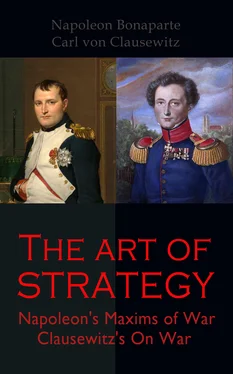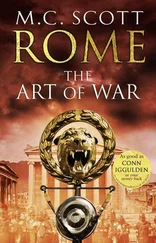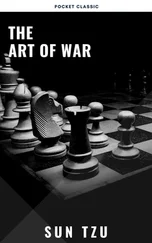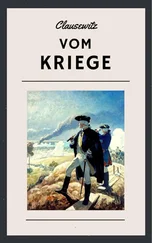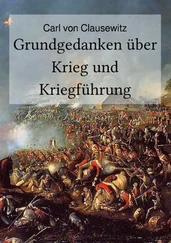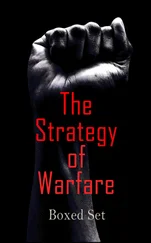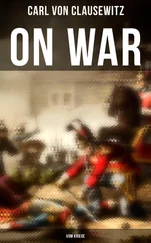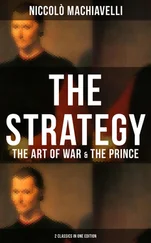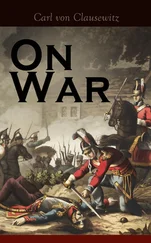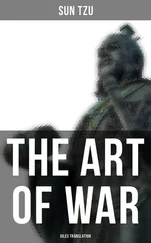Chapter III. Relation of Power
Chapter IV. Relation of the Three Arms
Chapter V. Order of Battle of an Army
Chapter VI. General Disposition of an Army
Chapter VII. Advanced Guard and Out-Posts
Chapter VIII. Mode of Action of Advanced Corps
Chapter IX. Camps
Chapter X. Marches
Chapter XI. Marches (Continued)
Chapter XII. Marches (continued)
Chapter XIII. Cantonments
Chapter XIV. Subsistence
Chapter XV. Base of Operations
Chapter XVI. Lines of Communication
Chapter XVII. On Country and Ground
Chapter XVIII. Command of Ground
Book VI. Defence
Chapter I. Offence and Defence
Chapter II. The Relations of the Offensive and Defensive to Each Other in Tactics
Chapter III. The Relations of the Offensive and Defensive to Each Other in Strategy
Chapter IV. Convergence of Attack and Divergence of Defence
Chapter V. Character of the Strategic Defensive
Chapter VI. Extent of the Means of Defence
Chapter VII. Mutual Action and Reaction of Attack and Defence
Chapter VIII. Methods of Resistance
Chapter IX. Defensive Battle
Chapter X. Fortresses
Chapter XI. Fortresses (Continued)
Chapter XII. Defensive Position
Chapter XIII. Strong Positions and Entrenched Camps
Chapter XIV. Flank Positions
Chapter XV. Defence of Mountains
Chapter XVI. Defence of Mountains (Continued)
Chapter XVII. Defence of Mountains (continued)
Chapter XVIII. Defence of Streams and Rivers
Chapter XIX. Defence of Streams and Rivers (continued)
Chapter XX. A. Defence of Swamps
B. Inundations
Chapter XXI. Defence of Forests
Chapter XX. The Cordon
Chapter XXIII. Key to the Country
Chapter XXIV. Operating Against a Flank
Chapter XXV. Retreat into the Interior of the Country
Chapter XXVI. Arming the Nation
Chapter XXVII. Defence of a Theatre of War
Chapter XXVIII. Defence of a Theatre of War—(continued)
Chapter XXIX. Defence of a Theatre of War (continued) Successive Resistance.
Chapter XXX. Defence of a Theatre of War (continued) When no Decision is Sought for.
Sketches for Book VII. The Attack
Chapter I. The Attack in Relation to the Defence
Chapter II. Nature of the Strategical Attack
Chapter III. Of the Objects of Strategical Attack
Chapter IV. Decreasing Force of the Attack
Chapter V. Culminating Point of the Attack
Chapter VI. Destruction of the Enemy’s Armies
Chapter VII. The Offensive Battle
Chapter VIII. Passage of Rivers
Chapter IX. Attack on Defensive Positions
Chapter X. Attack on an Entrenched Camp
Chapter XI. Attack on a Mountain
Chapter XII. Attack on Cordon Lines
Chapter XIII. Manœuvring
Chapter XIV. Attack on Morasses, Inundations, Woods
Chapter XV. Attack on a Theatre of War with the View to a Decision
Chapter XVI. Attack on a Theatre of War without the View to a Great Decision
Chapter XVII. Attack on Fortresses
Chapter XVIII. Attack on Convoys
Chapter XIX. Attack on the Enemy’s Army in its Cantonments
Chapter XX. Diversion
Chapter XXI. Invasion
Chapter XXII. On the Culminating Point of Victory
Sketches for Book VIII. Plan of War
Chapter I. Introduction
Chapter II. Absolute and Real War
Chapter III. A. Interdependence of the Parts in War
B. On the Magnitude of the Object of the War, and the Efforts to be Made.
Chapter IV. Ends in War More Precisely Defined Overthrow of the Enemy
Chapter V. Ends in War More Precisely Defined (continued) Limited Object
Chapter VI. A. Influence of the Political Object on the Military Object
B. War as an Instrument of Policy
Chapter VII. Limited Object—Offensive War
Chapter VIII. Limited Object—Defence
Chapter IX. Plan of War when the Destruction of the Enemy is the Object
Table of Contents
The Germans interpret their new national colours—black, red, and white—by the saying, “Durch Nacht und Blut zur licht.” (“Through night and blood to light”), and no work yet written conveys to the thinker a clearer conception of all that the red streak in their flag stands for than this deep and philosophical analysis of “War” by Clausewitz.
It reveals “War,” stripped of all accessories, as the exercise of force for the attainment of a political object, unrestrained by any law save that of expediency, and thus gives the key to the interpretation of German political aims, past, present, and future, which is unconditionally necessary for every student of the modern conditions of Europe. Step by step, every event since Waterloo follows with logical consistency from the teachings of Napoleon, formulated for the first time, some twenty years afterwards, by this remarkable thinker.
What Darwin accomplished for Biology generally Clausewitz did for the Life-History of Nations nearly half a century before him, for both have proved the existence of the same law in each case, viz., “The survival of the fittest”—the “fittest,” as Huxley long since pointed out, not being necessarily synonymous with the ethically “best.” Neither of these thinkers was concerned with the ethics of the struggle which each studied so exhaustively, but to both men the phase or condition presented itself neither as moral nor immoral, any more than are famine, disease, or other natural phenomena, but as emanating from a force inherent in all living organisms which can only be mastered by understanding its nature. It is in that spirit that, one after the other, all the Nations of the Continent, taught by such drastic lessons as Königgrätz and Sedan, have accepted the lesson, with the result that to-day Europe is an armed camp, and peace is maintained by the equilibrium of forces, and will continue just as long as this equilibrium exists, and no longer.
Whether this state of equilibrium is in itself a good or desirable thing may be open to argument. I have discussed it at length in my “War and the World’s Life”; but I venture to suggest that to no one would a renewal of the era of warfare be a change for the better, as far as existing humanity is concerned. Meanwhile, however, with every year that elapses the forces at present in equilibrium are changing in magnitude—the pressure of populations which have to be fed is rising, and an explosion along the line of least resistance is, sooner or later, inevitable.
As I read the teaching of the recent Hague Conference, no responsible Government on the Continent is anxious to form in themselves that line of least resistance; they know only too well what War would mean; and we alone, absolutely unconscious of the trend of the dominant thought of Europe, are pulling down the dam which may at any moment let in on us the flood of invasion.
Now no responsible man in Europe, perhaps least of all in Germany, thanks us for this voluntary destruction of our defences, for all who are of any importance would very much rather end their days in peace than incur the burden of responsibility which War would entail. But they realise that the gradual dissemination of the principles taught by Clausewitz has created a condition of molecular tension in the minds of the Nations they govern analogous to the “critical temperature of water heated above boiling-point under pressure,” which may at any moment bring about an explosion which they will be powerless to control.
The case is identical with that of an ordinary steam boiler, delivering so and so many pounds of steam to its engines as long as the envelope can contain the pressure; but let a breach in its continuity arise—relieving the boiling water of all restraint—and in a moment the whole mass flashes into vapour, developing a power no work of man can oppose.
Читать дальше
